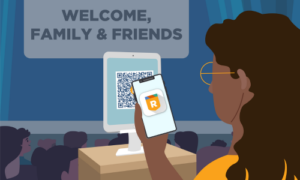This article originally appeared on Campus Safety. To view the original article, click here.
Panic button solutions have the same goal: to expedite awareness of and response to emergencies. But not all systems are created equal.
As you evaluate panic button solutions for your school or district, make sure to ask these seven questions.
1) Who can initiate the panic button and what information does it share with school staff, teachers, SROs, and first responders?
A best practice is to empower teachers and staff to be able to summon the right help and resources from wherever they are on campus, whether that help be a school administrator, onsite security personnel, law enforcement, the fire department, and/or health officials. The most powerful mobile panic button solutions greatly expedite awareness and response by doing just that, as well as enabling users to directly connect with 9-1-1 and send detailed, situation-specific notifications to a custom list of recipients. These alerts ideally sent across text message, email, voice call, and push notification should provide the type, location, and time of the incident and who initiated the emergency.
Because some staff move from one campus to another, it’s imperative that the tool can confirm exactly where each user is when they initiate a panic button and send alerts based on that location. This capability reduces the potential for false alarms, allows users to share their location on an interactive map, and seamlessly switch between campuses without having to worry about their panic button or the alerts that are sent out being tied to where their main office is. This expedites response by letting the appropriate personnel and first responders know exactly where they are needed.
2) Does it incorporate Enhanced 911 call routing?
Being in an emergency can jeopardize your ability to clearly communicate with responders, whether its due to stress, fear, losing connection, or being in a situation where you cannot verbally share critical details. Enhanced 911 (E911), informally referred to as location services for 911 calling, connects you to the appropriate PSAP that is closest to your location and automatically sends your validated physical location and telephone number to the connected operator. This helps ensure that responders are dispatched to the correct location even if the caller cannot verbally communicate their location with the operator. Basic911 calling, on the other hand, requires the distressed caller to tell the 911 dispatcher their location.
Your panic button solution should enable users to connect with dispatchers through E911 directly in a mobile app. A best-in-class mobile panic system does not require PSAPs to install software; the system should use the native 911 public safety infrastructure to route the call to the closest PSAP and intelligently know each jurisdictions routing processes. This automatically gives the dispatch operator the campus address and the callers callback number so first responders can quickly get on scene.
3) Is it in compliance with emerging state mandates such as Alyssas Law?
Named in remembrance of Alyssa Alhadeff, a victim of the 2018 Marjory Stoneman Douglas High School tragedy, Alyssas Law is critical legislation that addresses the issue of response time when a life-threatening emergency occurs. The law, already passed in New Jersey and Florida and pending in Texas, calls for the installation of silent panic alarms that are directly linked to first responders so they can get on the scene as quickly as possible, eliminate the threat, and triage any victims. To comply with Alyssas Law, a panic button alert system must directly link to multiple first responder agencies, ensuring real-time coordination.
4) Are users and first responders able to access critical school data like emergency protocols and floor plans?
Emergency response hinges on everyone having the information they need to act. Best practice is to have a panic button solution that allows users teachers, staff, first responders, and incident commanders, for example to have quick and easy access to your protocols, school maps, and other critical documents in one application. These documents should be accessible 24/7 on any web-enabled device, including the solutions mobile app.
5) How does the panic button solution support emergency response once the alerts are sent?
Alerting others that there is a crisis is only an initial step in emergency response. The panic button should also enable staff, first responders, and incident commanders to communicate in real-time through group messaging. Intuitive dashboards should be updating in real-time so incident commanders can see exactly what is happening from wherever they are located. This level of transparency allows emergency personnel to deploy resources where they’re needed most.
To fully protect everyone inside of your schools, your panic button needs to seamlessly integrate with a comprehensive emergency management platform that empowers you to:
- Summon the right help for any situation
- Account for each individual on campus, including visitors, contractors, guardians, and volunteers
- Reunify students with guardians
- Create instantaneous and updated status reports and after-incident reports
6) Can the panic button solution be customized to your specific needs?
Every district has different priorities, procedures, and challenges. The best technology is customizable to align to your school and district needs. Customizing your panic button solution to your emergency response protocols ensures that teachers, staff, and first responders stay in compliance with your policies and are speaking the same language during an emergency. Even as your protocols evolve over time, you can be confident that everyone is following your latest, most up-to-date procedures.
7) Can the panic button help schools respond to everyday, localized incidents?
Planning for wide-scale emergencies is critical, but issues related to localized incidents are more frequent. You’ve probably responded to more than one irate visitor, student fight, or flooded restroom. You know how these everyday situations can quickly escalate.
There is also a growing concern that we will see an increase in violent behavior as schools reopen and students return to the classroom. Students experiencing long-term emotional, behavioral, and psychological effects from the pandemic may be defiant and aggressive. Some students may also be in crisis depending on the stressors of their various situations. Further, The U.S. Secret Service Analysis of Targeted School Violence report analyzed incidents over one academic year and found that 41% happened within the first week back to school following a break. The panic button system should allow teachers and staff to summon help for localized scenarios so the appropriate personnel can respond to, identify, and resolve the issue.
Fully Protect Your Schools with an Integrated Solution
Investing in the right people and tools creates the ultimate benefit: safety and peace of mind for everyone in your community. When evaluating panic button solutions, consider how the solution meets your needs and supports a comprehensive emergency management approach.
A mobile panic alert system, Raptor Alert expedites awareness and response to localized incidents and school- or district-wide emergencies and is in compliance with Alyssas Law. Raptor Alert is a component of Raptor Emergency Management, which enables school districts to maintain real-time visibility during drills, active incidents, and reunification events.
To learn more about Raptor, contact us today to set up a personalized demo





